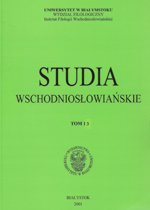Chorwacko-cerkiewnosłowiański przekład hymnu „Veni Creator Spiritus” jako przykład „powrotu” do redakcji narodowej w XIX wieku
Croatian-Church-Slavonic Translation of Hymn Veni Creator Spiritus as an Example of the Return to Croatian National Redaction in the 19th Century
Author(s): Marek WłodkowskiSubject(s): Christian Theology and Religion, South Slavic Languages, 17th Century, 18th Century, 19th Century, Translation Studies
Published by: Wydawnictwo Uniwersytetu w Białymstoku
Keywords: Glagolitic script; Croatia; Church Slavonic language and its editors;
Summary/Abstract: Of all the Roman-catholic countries, cultural heritage of Saint Brothers Ciril and Methody characterized by usage of glagolitic alphabet and Church-Slavonic language in liturgy survived the longest in Croatia. Church-Slavonic language kept on living there despite of antipathy of part of nonslavonic clergy due to maintaining its local (Croatian) redaction, open to interferences especially with Croatian chakavian and kajkavian dialects, in liturgical and literary function. It was also perceived as a useful means to promote union between Rome and Eastern Orthodox Churches, which resulted in introduction of many Eastern-Slavic elements into the language of liturgical books in 17th and 19th century. This tendency was opposed in 19th century by a Franciscan monk Dragutin Parčić who postulated a return to the original Croatian redaction. His Croatian-Church-Slavonic translation of Latinic Hymn Veni Crator Spiritus serves the as an example to study whether one may speak of a return to original redaction or a creation of a new one. Though small in size the text clearly shows lack of typical Eastern-Slavic features while those of Croatian redaction are shown in abundance. Still due to a complete absence of dialectical characteristics and consequent features of its orthography the hymn could not be confused with earlier texts.
Journal: Studia Wschodniosłowiańskie
- Issue Year: 2014
- Issue No: 14
- Page Range: 291-303
- Page Count: 13
- Language: Polish

